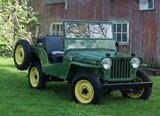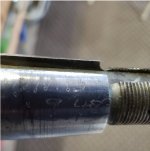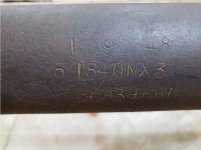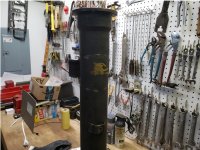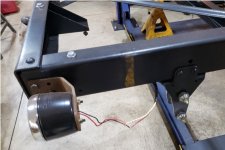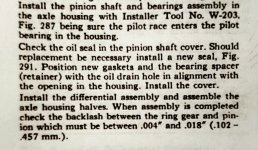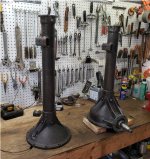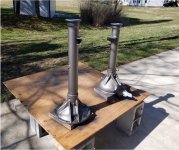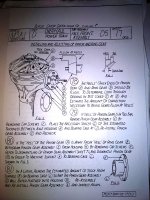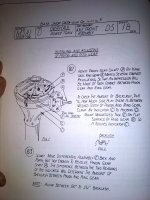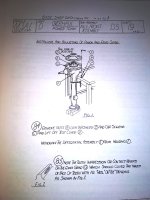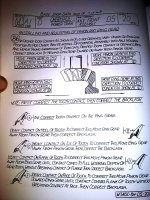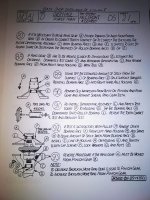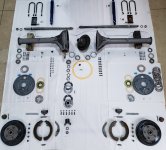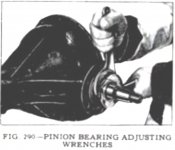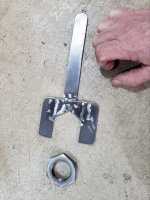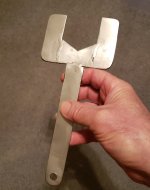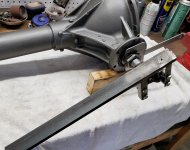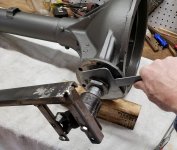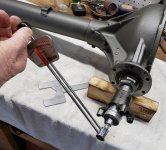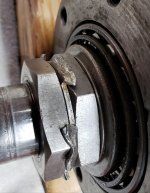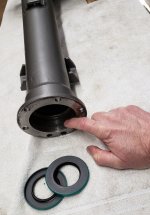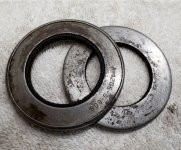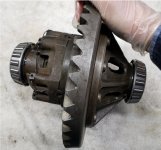Let's get this thing assembled, already..... (with a very brief video for @Stakebed again!)
So as above, the Magic Words had come from
@Jon and his old Manual - which actually told us
how to do what the Willys Manual did not. So using that new knowledge -
March 14, 2020:
"... OK, using the method Jon shared from the old Manual, I have measured backlash. It seems to be a valid measurement. First, I had to customize the dial indicator probe -
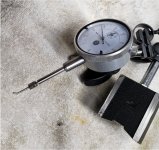 so I could "reach around the corner" and make contact with the ring gear tooth.
I'm getting .012 to .014-ish. The zero point bounces around, and it's hard to not jiggle the pinion a little. First few tries showed me. 011. So spec is .004 to .018. I'm calling it good.
Here's a 5 second video of the effort -
(OK, it wasn't much of a video....)
I have also reworked my fixture setup that holds the axle housings, so I can put this thing together by myself.
so I could "reach around the corner" and make contact with the ring gear tooth.
I'm getting .012 to .014-ish. The zero point bounces around, and it's hard to not jiggle the pinion a little. First few tries showed me. 011. So spec is .004 to .018. I'm calling it good.
Here's a 5 second video of the effort -
(OK, it wasn't much of a video....)
I have also reworked my fixture setup that holds the axle housings, so I can put this thing together by myself.
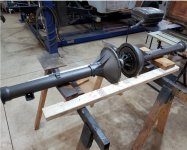 Going to try to get a pattern next. "
Going to try to get a pattern next. "
And I did! Just a short while later, the same afternoon -
"
... I believe we have a good, solid pattern!!!!!!
Feedback is very welcome, because (don't tell anybody) I only vaguely know what the hell I'm doing.....
I rotated 2 revolutions in both directions. (This time, I didn't use too much of the yellow paint, too. Better.) I used the original gasket as a spacer.
Here's some patterns: ( <---
I'm only putting up two of them here.... you're welcome! haha)
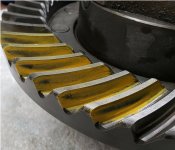
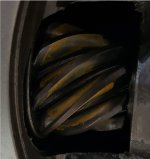 My modified assembly fixture worked out pretty good. I was able to easily get it together and apart by myself pretty quickly.
The new bearings and cups lined up and seated fine, and seemed happy enough while turning things. And looked normal after pulling it back apart.
Nice to see it in one piece again. For a minute, anyway. "
My modified assembly fixture worked out pretty good. I was able to easily get it together and apart by myself pretty quickly.
The new bearings and cups lined up and seated fine, and seemed happy enough while turning things. And looked normal after pulling it back apart.
Nice to see it in one piece again. For a minute, anyway. "
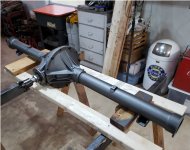
Well, my primary mentor -
@JABJEEP (sometimes known as The Lone Ranger, as I recall....) said simply -
".. Excellent! Get that thing under the truck!"
BUT - alas - just when you thought I was almost
DONE with this little Timken project - I discovered I had still yet
another procedure to perform that I didn't quite understand....
March 15, 2020:
"...That's what I was hoping you'd say! I'll hopefully get it put together today but not under the truck. Gotta build the backing plates, brakes, etc etc. on it. And get the Frame and new rear springs truly ready to receive it for keeps.
But the next thing that has me scratching my head is shimming the axles, to set endplay. I understand I'm going to shim under the backing plate. I understand it doesn't matter which side I put them on; and I've got the spec.
What I DON'T understand is what I'm measuring, where I'm measuring it at, and how I'm measuring it...."
JabJeep -
" You're measuring endplay at the end of the axle with your dial indicator. You should actually be able to push and pull the shaft the 0.004" or whatever the spec is, by hand, or maybe put a hub, or the nut on it and pry against that. "
And I got thinking too much again....
".. Oh..... well, that seems pretty straight forward. I believe I can handle that. Thank you.
OK, next thing - how does that (tapered bore) wheel bearing "know how far" to slide on the axle? I was thinking about this yesterday as I polished the carrier shafts to put those bearings on. Doing the old shoe-shine move. I got thinking I should probably do that same process to the axles before I installed those bearings too. Then I remembered they're tapered. If I polished the axle, they would slide on further. But if the axle NEEDS polished, they won't slide on far enough....
Any thoughts on rubbing a little assembly lube on the carrier bearings and pinion components as I button up that pumpkin? It's gonna be a while before it starts spinning next....
Thinking further.... it'll be fine. The pumpkin will be filled with gear oil before it starts spinning significantly, after all - and it will then do what it's supposed to do. No different than when a vehicle is parked for 2 weeks or however long, and everything has drained down.
(Im just kinda talking to myself here..... hmmm.... ) "
Well, he and others talked me down. We proceeded.....
"... Ok, all good here then. Yes, I oiled the bearings, and ran an oily finger around the races. Also squeezed a bit into the planetary gears and pinion areas just before marrying it up.
I will definitely hand-pack the wheel bearings. By the way, some playing around this morning showed that the wheel bearings "know" how far to slide onto the axle shafts. At least visually (since there's nothing to measure) they appear to be in the same spot as the old ones were.
The long, flimsy gasket was bitchy to work with. (I have spared you the long conversation about how to find paper of the correct thickness (it matters, and it's not readily available anywhere)) for this gasket. I ended up making it out of a manilla envlope). I put a very light finger of gasket goop all around both side's surfaces, which helped glue down the gasket for assembly. So it's married together now.
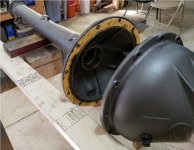
Time to install wheel bearings, and see what we have for axle end-play."
Then I wandered into that quagmire of conversation about the "right" gear oil to put in this wonderful old rearend. Bottom line - yes, there's some yellow metal in there - use GL-4, not the much more widely available GL-5 stuff.
Still later that same day, The "Ides of March" -
"... I've made it to the part where I measure and shim, to set the axle end-play. Spec is .003" to .007". Got things snugged up, and the first reading (using the old shim pack which I have previously meticulously cleaned up) is luckily showing me .030" end-play. I say "luckily" because that means I need to REMOVE shims. I can do that. If I had needed to ADD shims, I don't have any more, I'd be looking for some before I could finish this.
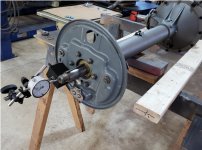 Kept playing with it, decided it really said .033". Took it apart, pulled out three .010 shims, back together. Now it was at zero. Took it apart, pulled out the only .005 and added back one of the .010's. Put it together and it reads .006". I'm calling it done. But I have to unbolt again to install the outer seals and gaskets.
Then the pinion seal and cover, various small parts, and on to building the brakes.
Kept playing with it, decided it really said .033". Took it apart, pulled out three .010 shims, back together. Now it was at zero. Took it apart, pulled out the only .005 and added back one of the .010's. Put it together and it reads .006". I'm calling it done. But I have to unbolt again to install the outer seals and gaskets.
Then the pinion seal and cover, various small parts, and on to building the brakes.
Everything I know to look at is now "in spec." ... "
Got the pinion seal and cap installed, the breather, brake line brackets. We'll see if I get any time tomorrow. It's getting close! "
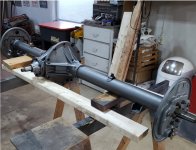
.


